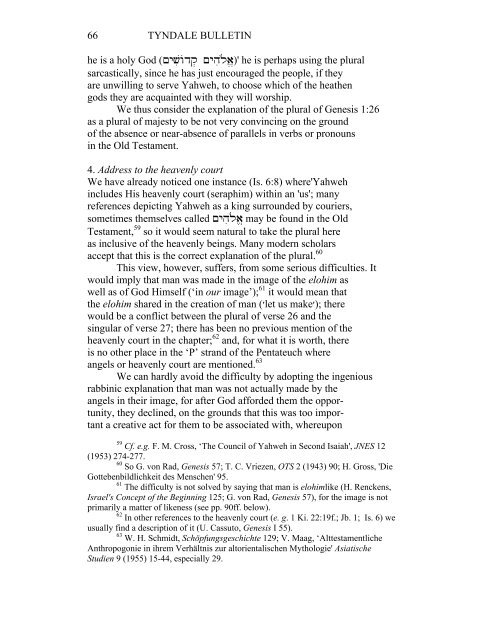THE IMAGE OF GOD IN MAN - Tyndale House
THE IMAGE OF GOD IN MAN - Tyndale House
THE IMAGE OF GOD IN MAN - Tyndale House
- TAGS
- tyndale
- tyndalehouse.com
Create successful ePaper yourself
Turn your PDF publications into a flip-book with our unique Google optimized e-Paper software.
66 TYNDALE BULLET<strong>IN</strong><br />
he is a holy God ( םיִ ׁש ֹודְק םיִהֹל ֱא)'<br />
he is perhaps using the plural<br />
sarcastically, since he has just encouraged the people, if they<br />
are unwilling to serve Yahweh, to choose which of the heathen<br />
gods they are acquainted with they will worship.<br />
We thus consider the explanation of the plural of Genesis 1:26<br />
as a plural of majesty to be not very convincing on the ground<br />
of the absence or near-absence of parallels in verbs or pronouns<br />
in the Old Testament.<br />
4. Address to the heavenly court<br />
We have already noticed one instance (Is. 6:8) where'Yahweh<br />
includes His heavenly court (seraphim) within an 'us'; many<br />
references depicting Yahweh as a king surrounded by couriers,<br />
sometimes themselves called םיִהֹל ֱא may be found in the Old<br />
Testament, 59 so it would seem natural to take the plural here<br />
as inclusive of the heavenly beings. Many modern scholars<br />
accept that this is the correct explanation of the plural. 60<br />
This view, however, suffers, from some serious difficulties. It<br />
would imply that man was made in the image of the elohim as<br />
well as of God Himself (‘in our image’); 61 it would mean that<br />
the elohim shared in the creation of man (׳let us make׳); there<br />
would be a conflict between the plural of verse 26 and the<br />
singular of verse 27; there has been no previous mention of the<br />
heavenly court in the chapter; 62 and, for what it is worth, there<br />
is no other place in the ‘P’ strand of the Pentateuch where<br />
angels or heavenly court are mentioned. 63<br />
We can hardly avoid the difficulty by adopting the ingenious<br />
rabbinic explanation that man was not actually made by the<br />
angels in their image, for after God afforded them the opportunity,<br />
they declined, on the grounds that this was too important<br />
a creative act for them to be associated with, whereupon<br />
59<br />
Cf. e.g. F. M. Cross, ‘The Council of Yahweh in Second Isaiah', JNES 12<br />
(1953) 274-277.<br />
60<br />
So G. von Rad, Genesis 57; T. C. Vriezen, OTS 2 (1943) 90; H. Gross, 'Die<br />
Gottebenbildlichkeit des Menschen' 95.<br />
61<br />
The difficulty is not solved by saying that man is elohimlike (H. Renckens,<br />
Israel's Concept of the Beginning 125; G. von Rad, Genesis 57), for the image is not<br />
primarily a matter of likeness (see pp. 90ff. below).<br />
62<br />
In other references to the heavenly court (e. g. 1 Ki. 22:19f.; Jb. 1; Is. 6) we<br />
usually find a description of it (U. Cassuto, Genesis I 55).<br />
63<br />
W. H. Schmidt, Schöpfungsgeschichte 129; V. Maag, ‘Alttestamentliche<br />
Anthropogonie in ihrem Verhältnis zur altorientalischen Mythologie' Asiatische<br />
Studien 9 (1955) 15-44, especially 29.

















